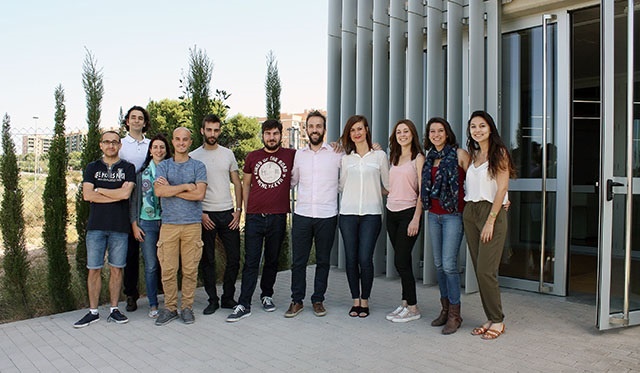A team from the Integrative Systems Biology Institute (I2SysBio), mixed centre of the Universitat de València and the Spanish National Research Council (CSIC), has set out a ‘social component’ that had not been described so far, consisting in an aggregation mechanism to ease their propagation. The work, published at ‘Nature Microbiology’ demonstrates this hypothesis in the virus of vesicular stomatitis.
José Manuel Cuevas, María Durán Moreno and Rafael Sanjuán question with this research the classic vision that says that virus populations are formed by particles that behave independently during the infection process, without any interaction with each other. Through their analysis, they have described that the virus of vesicular stomatitis –a disease with a viral origin that affects the bovine, equine and porcine species and is transmissible to humans– can use aggregation mechanisms as a strategy to facilitate its propagation.
Large numbers of animal viruses are enveloped in a lipid bilayer taken from cell membranes. Given the fact that proteins bind to these membranes to initiate infection, the work carried out at Rafael Sanjuán’s laboratory and directed by him sets out that free virions (morphologically complete and infectious viral particles) may also be able to interact extracellularly with the membrane of other virions.
“Our findings contrast with the commonly accepted perception of virions as passive propagators and show the ability of viruses to establish collective infectious units, a fact that could ease the evolution of interactions between viruses”, said José Manuel Cuevas, María Durán Moreno and Rafael San Juan.
“We also show that, following the establishment of these contacts, different viral genetic variants are co-transmitted to the same cell”, said the researchers at I2SysBio. The results of the article «Multi-virion infectious units from free viral particles in an enveloped virus» allow to explain previous observations in the scientific literature that show how some defective viruses (those incapable of being replicated after the infection that they provoke in the host cell except in the presence of another viable virus) have been successfully transmitted for prolonged periods of time.
“The design of strategies for fighting viral diseases changes radically if we consider that viruses can present this social component. We would be speaking of collective infectious units that could ease virus-virus interactions”, points out José Manuel Cuevas, Ramón y Cajal researcher of the Universitat de València and main author of the work. The researcher also highlights that this new scenario “presents important implications regarding adaptation dynamics of the viruses, such as multi-resistance generation”.
The research has been developed at Rafael Sanjuán’s laboratory of the Institute for Systems and Integrative Biology (I2SysBio), located in the Parc Científic of the Universitat de València, using different biological showings: saliva from two to six year old cows; saliva of four people, three men and one woman between 25 and 41 years; and blood plasma from volunteer donors of the Hospital General of Valencia.
This work has been developed within the framework of the European project Collective Infectious Units and the Social Evolution of Viruses (ERC Consolidator) that investigates the social behaviour of viruses using different models, and has been financed by the Ministry of Economy and Competitiveness.
The group Evolución y Salud (Evultion and Health) is a mixed research unit located at I2SysBio and the Public Health FISABIO centre. Rafael Sanjuán's laboratory (I2SysBio) has worked on the study of viral mutation mechanisms, although recently it is developing new lines of research aimed at the experimental evolution of oncolytic viruses, as well as the study of the social behaviour of viruses, which encompasses the present research work.
Article:
José M. Cuevas, María Durán-Moreno and Rafael Sanjuán: «Multi-virion infectious units arise from free viral particles in an enveloped virus». Nature Microbiology 2, 17078 (2017). Published 22 May 2017 DOI: 10.1038/nmicrobiol.2017.78


